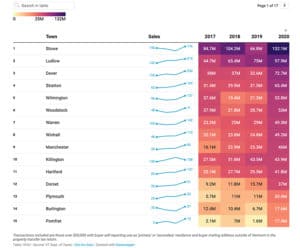By Erin Petenko/VTDigger
Sales of Vermont homes to out-of-state buyers jumped 38% in 2020 over the year before, suggesting that the pandemic drove newfound interest in Vermont real estate.
According to data collected by the state Dept. of Taxes and newly analyzed by the Vermont Center for Geographic Information, home sales to out-of-staters reached their highest level in years, despite a slowdown in early 2020. Such sales peaked in late October of that year. The analysis covers sales between January 2017 and January 2021.
The 38% increase in 2020 compares to a 3% increase the year before and no change the year before that.
The tax department logged 3,795 sales to out-of-state buyers in 2020, compared to 2,750 in 2019. That represents about 27% of all residential sales in 2020, according to Deputy Tax Commissioner Rebecca Sameroff.
The value of that real estate increased even more: $1.43 billion in residential real estate was sold to out-of-staters in 2020, a 79% increase over the $799 million sold the year before.
The findings were gleaned from records collected by the state when it taxes property transfers.
The data comes with several stipulations. The Vermont Center for Geographic Information excluded from its analysis transactions under $20,000 to account for sales of timeshares and other blips in the data, according to John Adams, the center’s director.
The analysis is also based on mailing addresses submitted to the tax department at the time of purchase, but that may not reflect residency.
The data nevertheless provide a glimpse at how residential sales changed during the pandemic and suggest that, at some level, newcomers showed new interest in Vermont in 2020.
“It’s a proxy. It’s by no means a perfect measure,” Sameroff said. “But there’s certainly an undeniable increase in people buying property from out-of-state addresses.”

Transactions included are those over $20,000 with buyer self reporting use as ‘primary’ or ‘secondary’ residence and buyer mailing address outside of Vermont in the property transfer tax return.
Geographic patterns
In 2020, residential sales to out-of-staters were higher in southern Vermont, the Mad River Valley, and Lamoille and Chittenden counties, the data show.
They were particularly high in ski areas. Stowe led the state with $132 million in sales from 176 transactions.
Ski areas dominated out-of-state sales in previous years, as well. The 10 communities accounting for the most in sales were virtually identical from 2019 to 2020. The biggest change came in Killington, which rose to third-highest in 2019 ahead of other ski towns, but then dropped to 10th place in 2020 even as 2020 hit a new record.
While the names of the top towns didn’t change much, the numbers did. Each of those towns had more sales in 2020 than in 2019. Stowe, for example, had 120 sales in 2019 and 176 in 2020, a 47% increase.
KC Chambers, a Realtor at Red Barn Realty in Stowe, said the data aligned with what he’s noticed in clients: a desire to move to the area or to own a home after renting.
“They liked it here in the past, did a lot of quarantining here, maybe got a rental here and liked it,” he said. “They could see living here full time, but otherwise they think they could spend a chunk of time here and rent it out when they’re not here.”
Chambers’ clients wanted a variety of different types of properties, but they often requested broadband internet, he said. Many also looked for properties with great office space.
Asked if he thought his clients would stay long term, he said their continued ability to work remotely could be a “driver” of whether they would be permanent or temporary Vermonters, particularly in communities that don’t have enough jobs to support their new residents.
But Chambers said it was difficult to draw broad conclusions about those moving to town. “Much as people would like to put these new people in one bucket, I don’t think that’s possible,” he said.
“When you ask, ‘What are you gonna do?’ We’re all in that,” he said.




